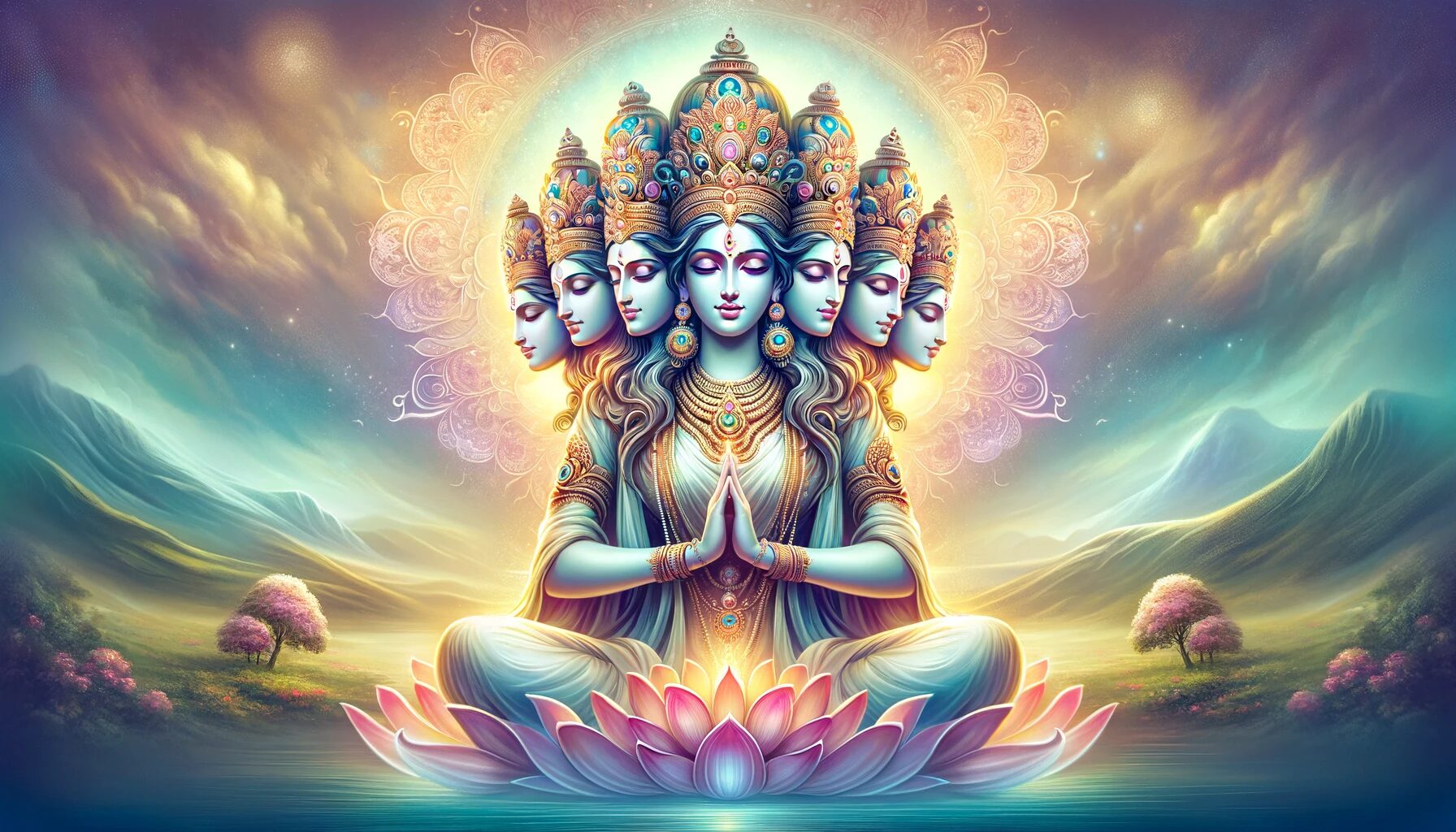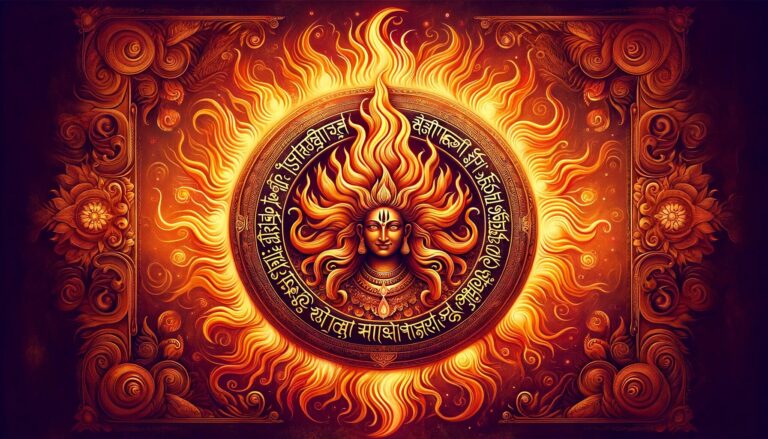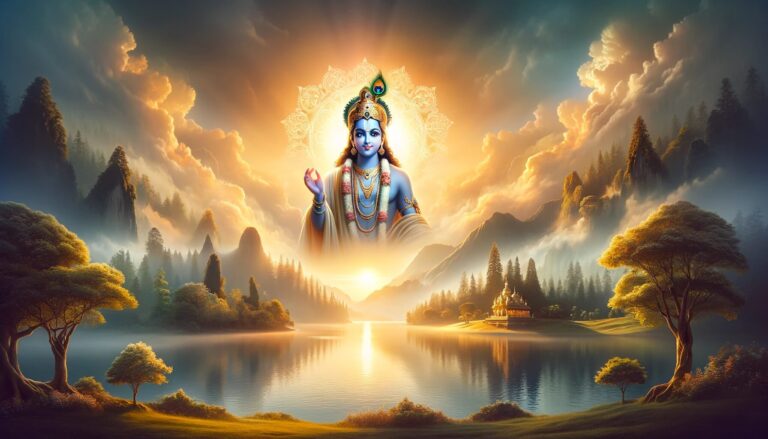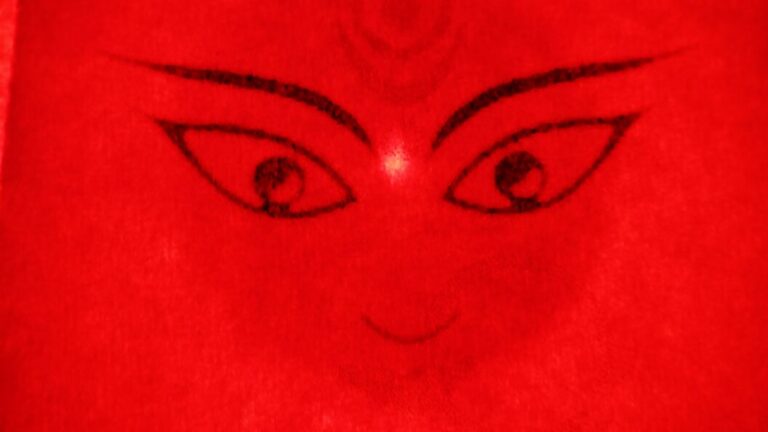Welcome, spiritual explorer!
Ready to uncover the secrets of the Gayatri Mantra?
It’s more than just words – it’s a cosmic journey.
Simple, yet profound, this ancient chant connects us with universal wisdom. No need to be a Sanskrit expert; we’re keeping it easy and enlightening.

Let’s begin this soulful voyage! 🌟🙏
Also Read – Agni Gayatri Mantra
Gayatri Mantra Lyrics In English
Ah, the heart of our journey – the Gayatri Mantra itself!
Now, this isn’t just any chant; it’s a melodious blend of divinity and wisdom.
Let’s immerse ourselves in its lyrics, shall we?
Here it goes:
Om Bhur Bhuvaḥ Swaḥ
Tat-savitur Vareñyaṃ
Bhargo Devasya Dhīmahi
Dhiyo Yonaḥ Prachodayāt
Did you feel that?
It’s like a gentle wave of peace washing over us. Simple, isn’t it?
But oh, the depth it holds is immense!
Each word is a drop of spiritual nectar, waiting to be savored.
And guess what?
You don’t need to be a pro to chant it. Whether you’re in your cozy room or out in nature, these words can be your serene companions.
Let them flow, let them soothe your soul.
Up next, we’ll unravel the meanings hidden in each word.
Stay tuned, because that’s where the real magic unfolds!
Gayatri Mantra Word By Word Meaning
Alright, let’s put on our detective hats and decode this mantra, word by word!
Each word in the Gayatri Mantra is like a key, unlocking a deeper understanding.
So, let’s get to it!
- “Om” (ओम्): The universal sound, symbolizing the ultimate reality or consciousness.
- “Bhur” (भूर्): Represents the earth, the physical body, and life.
- “Bhuvaḥ” (भुवः): Symbolizes the mental world, consciousness, and the realm of feelings.
- “Swaḥ” (स्वः): The celestial, spiritual plane, denoting the soul and higher states of being.
- “Tat” (तत्): Means ‘that’, indicating the Ultimate Reality or Brahman.
- “Savitur” (सवितुर्): Refers to the divine sun, the creator, and source of all life.
- “Vareñyam” (वरेण्यम्): Desirable, worthy of worship and respect.
- “Bhargo” (भर्गो): The divine light that dispels ignorance and illuminates the path.
- “Devasya” (देवस्य): Divine, supreme, indicating the divine essence.
- “Dhīmahi” (धीमहि): We meditate upon or imbibe these qualities.
- “Dhiyo” (धियो): Intellect, understanding, and discernment.
- “Yo” (यो): Who or that which.
- “Nah” (नः): Our, indicating collective consciousness.
- “Prachodayāt” (प्रचोदयात्): Enlighten, guide, inspire towards the right path.
In essence, the Gayatri Mantra is a humble yet powerful invocation for illumination, guidance, and wisdom, seeking the divine light to brighten our intellect and guide our inner journey towards truth and self-realization.
It’s a sacred chant that connects us with the cosmic energy and elevates our consciousness.
Power of Gayatri Mantra
The Gayatri Mantra isn’t just a chant; it’s a powerhouse of spiritual energy.
Imagine it as a spiritual battery charger, giving a boost to your inner self! This mantra is known for its ability to improve concentration and bring clarity to the mind. It’s like having a mental filter, helping us sift through the noise of daily life and focus on what truly matters.
And there’s more – it’s believed to nurture and balance our chakras, those swirling wheels of energy inside us.
Chanting the Gayatri Mantra is like a spiritual workout for your soul, aligning and energizing your inner self. It’s not just about the words; it’s the rhythm and vibration that work their magic.
Fun Fact: Did you know that the frequency of the chant can have a calming effect on your mind? It’s like a lullaby for your brain, soothing and relaxing.
And who doesn’t love a bit of tranquility in their life?
So, when you chant the Gayatri Mantra, you’re not just reciting words; you’re inviting a wave of peace, focus, and spiritual energy into your life.
It’s like opening a door to a more serene and enlightened you!
Rules For Chanting Gayatri Mantra
Chanting the Gayatri Mantra is like stepping into a spiritual dance, and there are a few simple steps to follow.
First, the right time: early morning, known as Brahma Muhurta, is perfect. It’s that serene time when nature wakes up – a peaceful backdrop for a spiritual practice.
Now, the posture: sitting straight, preferably in a calm and clean space, helps in maintaining focus. It’s like setting the stage for a sacred performance.
And here’s the catch – it’s not just about saying the words; it’s about feeling them. Each syllable should be pronounced clearly, with heartfelt devotion. Imagine infusing each word with your deepest respect and sincerity.
Quick Tip: Remember, the power lies in consistency. Regular chanting amplifies its benefits. So, make it a part of your daily routine, like your morning cup of coffee!
Let’s keep it light-hearted, though. No need to stress if you miss a day or two.
The mantra is about peace and positivity, not perfection.
Happy chanting!
Gayatri Mantra Side Effects
The Gayatri Mantra is like a spiritual vitamin, mostly all good, but with a few notes of caution.
It’s powerful, and like any potent tool, it needs to be used wisely.
Some believe that incorrect chanting could lead to negative effects, but let’s not get bogged down by fear. The key is respect and understanding.
Remember, it’s more about the intent and less about perfection.
Approach the mantra with a clear and positive mindset. If you’re ever in doubt, seek guidance from someone experienced, like a spiritual mentor.
It’s like asking for directions on a journey – it’s always okay to ask!
And here’s something to ponder: the power of any spiritual practice lies in belief and respect. So, while chanting, keep your heart open and your intentions pure. It’s less about the risk of side effects and more about the journey towards enlightenment.
Keep it light, keep it respectful, and let the mantra work its magic!
Gayatri Mantra In Sanskrit
The Gayatri Mantra in its original Sanskrit form is like a timeless melody, resonating with a rhythm that transcends ages.
Here it goes:
ॐ भूर्भुव: स्व: तत्सवितुर्वरेण्यं । भर्गो देवस्य धीमहि, धीयो यो न: प्रचोदयात् ।।
Gayatri Mantra 1008 Times, 21 Times, and 11 Times
Chanting the Gayatri Mantra a specific number of times carries its own unique significance.
Let’s explore these variations:
- 11 Times: A great starting point for beginners. It’s like dipping your toes in the spiritual ocean, just enough to feel the essence.
- 21 Times: This is for those looking to deepen their practice. Think of it as a more intense session of spiritual connection, like turning up the volume on your favorite song.
- 1008 Times: This is the ultimate spiritual marathon. It’s a profound commitment, requiring dedication and focus. Chanting the mantra 1008 times is like embarking on a long, transformative journey, where each repetition is a step towards higher consciousness.
Remember, it’s not about the count; it’s about the intention.
Whether you chant 11, 21, or 1008 times, what matters most is the devotion and sincerity in your heart.
It’s not a race; it’s a journey.
So, choose your pace and let the mantra’s rhythm guide you to inner peace and enlightenment.
Conclusion
As we wrap up our journey through the Gayatri Mantra, remember, it’s more than just words; it’s a spiritual experience. This ancient chant is not just about recitation; it’s about connecting with a deeper part of ourselves and the universe.
Whether you’re a seasoned practitioner or new to this path, the Gayatri Mantra offers a space for peace, contemplation, and spiritual growth.
Take these insights with you, let the mantra resonate in your daily life, and watch as it transforms your spiritual journey.
Remember, it’s your intent and dedication that count.
May your path be illuminated with the light of wisdom and clarity that the Gayatri Mantra brings.
Frequently Asked Questions
What is the Gayatri Mantra?
The Gayatri Mantra is a highly revered verse from the Rig Veda, dedicated to Savitar, the sun deity. It is named after the Gayatri meter in which it is composed and is known for its spiritual depth.
Can the Gayatri Mantra be chanted at any time?
Yes, the Gayatri Mantra can be chanted at any time of the day. While traditional practice recommends chanting during Brahmamuhurta (early morning), noon, and dusk, it can also be recited at other times with a focus on correct pronunciation and intention.
Can women chant the Gayatri Mantra?
Yes, women can chant the Gayatri Mantra. There is no scriptural restriction preventing women from chanting it. This misconception from the middle ages has been corrected in many spiritual communities, affirming the equal spiritual rights of women.
Can the Gayatri Mantra be chanted at night, and why is it not recommended?
Traditionally, the Gayatri Mantra should not be chanted at night. The ideal times for chanting are during the morning, noon, and sunset, aligning with the sun’s presence. This practice stems from the mantra’s deep connection with the sun deity, Savitur, and the belief that its spiritual benefits are amplified during these specific times of the day. Chanting at night is typically avoided as it does not coincide with the solar energies that the mantra venerates.
Can the Gayatri Mantra be chanted during menstrual periods?
Yes, the Gayatri Mantra can be chanted during menstrual periods. It is considered that the intention and devotion behind the chanting are more significant than the physical state of the practitioner. While maintaining focus and concentration during chanting is emphasized, there are no specific restrictions against chanting the Gayatri Mantra during periods.
What is the best time to chant the Gayatri Mantra?
The best time to chant the Gayatri Mantra is typically during the early morning hours at sunrise, as well as during noon and sunset. These times align with the traditional Vedic understanding of the day’s spiritual segments, with the early morning considered particularly conducive for meditation and chanting. While these are traditionally recommended times, the mantra can be chanted at other times too, with the focus on the practitioner’s sincerity and devotion.
Why is it called the Gayatri Mantra?
It’s called the Gayatri Mantra because it is composed in the Gayatri meter, a specific poetic structure in Vedic Sanskrit, rather than being named after the deity it addresses.
What is the difference between the Gayatri Mantra and the Savitri Mantra?
The Gayatri Mantra is sometimes referred to as the Savitri Mantra due to its invocation of Savitar, the sun deity. However, its correct name is the Gayatri Mantra, referring to its meter, not the deity.
Can anyone chant the Gayatri Mantra?
Yes, the Gayatri Mantra is a universal prayer that can be chanted by anyone, irrespective of their religious or spiritual background. Its chanting is believed to bring peace, prosperity, and happiness.
Who is Goddess Gayatri?
Goddess Gayatri is a deity in Hinduism, often identified with Saraswati, Savitri, or Vedamata. She is revered as the embodiment of the Gayatri Mantra and symbolizes supreme pure consciousness. Depicted with five heads, Gayatri is seen as a manifestation of all-encompassing wisdom, representing the union of physical and spiritual realms. She holds a significant place in Hindu philosophy and worship, embodying enlightenment and spiritual knowledge.



